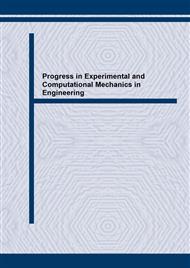[1]
G. Yagawa and R. Shioya, Parallel finite elements on a massively parallel computer with domain decomposition. Computing systems in Engineering 4:4-6, 495-503.
DOI: 10.1016/0956-0521(93)90017-q
Google Scholar
[2]
R. Shioya and G. Yagawa, Parallel finite elements of ten-million DOFs based on domain decomposition method. WCCM IV, Computational Mechanics -New Trends and Applications- VII:5-11, 1-12.
Google Scholar
[3]
Y. H. De Roeck and P. Le Tallec, Analysis and test of a local domain decomposition preconditioner. Fourth International Symposium on Domain Decomposition Methods for Partial Differential Equations, SIAM, Philadelphia, PA
Google Scholar
[4]
J. Mandel, Balancing domain decomposition. Communications on Numerical Methods in Engineering 9, 233-241. 6 Title of Publication (to be inserted by the publisher) Fig.1� Beam model 0 200 400 600 800 1000 1200 1400 12 20 28 36 44 52 64 76 96 128 192 Number of subdomains Number of iterations HDDM BDD 0 5 10 15 20 25 30 35 12 20 28 36 44 52 64 76 96 128 192 Number of subdomains Time [sec] HDDM BDD Fig.2� Number of subdomains vs number of iterations Fig.3� Number of subdomains vs time Fig.4 Pressure vessel mesh with 8 part Fig.5 Stress distribution of pressure vessel model 1.0E-07 1.0E-06 1.0E-05 1.0E-04 1.0E-03 1.0E-02 1.0E-01 1.0E+00 1.0E+01 1.0E+02 1.0E+03 0 1000 2000 3000 4000 5000 6000 Number of iterations Relative residual norm HDDM BDD Fig.6 History of residual norm in pressure vessel model
Google Scholar


